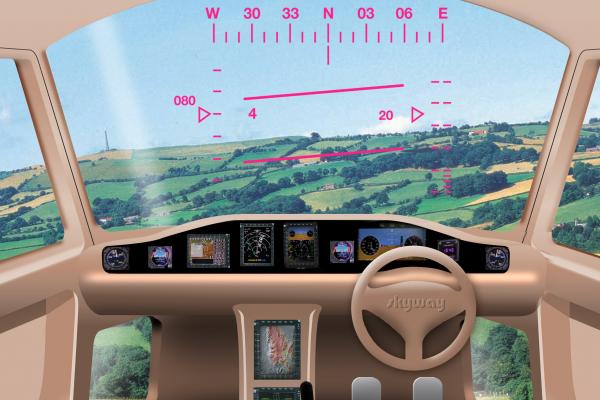It’s one of a handful of radical ideas for improving Europe’s congested cities that also includes hydrogen-powered postal delivery vehicles and electric boats riding on a cushion of air.The EU has committed to cut its greenhouse gas emissions to 20 % below 1990 levels for 2020, and road transport currently contributes around a fifth of Europe’s total emissions of carbon dioxide.Emissions-saving hybrid electric cars are becoming increasingly popular, and the fuel efficiency of standard cars improved by 22 % during the period 1995-2009, according to data supplied by the European Petroleum Industry Association. On top of that, hydrogen-powered buses whose only emission is water vapour are now being tested on Europe’s roads as part of the Clean Hydrogen in European Cities project.However, the World Health Organization forecasts that by 2050 seven out of 10 people will live in a city, meaning Europe needs to find more innovative ways of cutting down on pollution and congestion.Car-like vehicles that can fly‘Now we have cars everywhere, it does not make sense to build more roads, because we cannot even maintain all the current roads and in many places there is no room left anymore,’ said Professor Heinrich H. Bülthoff of the Max Planck Institute for Biological Cybernetics in Germany. ‘So why not use the third dimension, and make car-like vehicles that are able to fly?’He is scientific coordinator of the myCopter project, an EU-funded consortium which is preparing the ground for small aerial vehicles to be used as personal transport. It has six partners, including DLR, Germany’s national space and aeronautics research centre, which will provide its flight simulation facilities to test the systems developed.“’Now we have cars everywhere, it does not make sense to build more roads, because we cannot even maintain all the current roads, and in many places there is no room left anymore … So why not use the third dimension, and make car-like vehicles that are able to fly?’Professor Heinrich H. Bülthoff, of the Max Planck Institute for Biological Cybernetics in GermanyMyCopter will not itself build personal vertical-lift aircraft, but is studying what systems and technologies are needed for them to become a reality.As well as the technical issues of developing a small vertical take-off commuter vehicle with a range of 50-100 km, researchers are also considering factors such as noise, safety, and economy. The social acceptability of automated or near-automated vehicles flying overhead is an important issue, Prof. Bülthoff said.MyCopter aims to keep down the costs, but personal helicopter-type vehicles are likely to be used by ‘early adopters’ initially, rather than immediately being a mass form of transport.‘We think when you take everything into account – how much energy you waste in traffic and not being able to follow a direct route – even with current technology you come into the range of a middle-class car in terms of fuel consumption. Hopefully with electric motors or helicopter-like systems, we could be environmentally more friendly,’ Prof. Bülthoff said.Zero-emission ferriesCommuting by water as an alternative to road, is another field of research receiving EU support, with zero-emission fast ferries rapidly becoming a possibility.The BB Green consortium, with partners in Norway, Sweden, Belgium, the Netherlands, and Britain, is developing a fast ferry powered by batteries, rather than diesel.The vessel will carry 60-80 passengers and 20-30 bicycles and already has Europe’s biggest port, the Port of Rotterdam, as a partner and potential client.The BB Green system uses an electric fan to raise most of the ferry above the water.The BB Green system uses an electric fan to raise most of the ferry above the water.The BB Green system uses an electric fan to raise most of the ferry above the water.‘We are creating a cushion of air underneath the hull and the boat is lifted out of the water like a hovercraft,’ said Ulf Tudem, of Norwegian firm SES Europe, Coordinator of the BB Green project.‘But we don’t have any rubber skirts or bags that are the Achilles’ heel of these old-fashioned air-assisted hull forms. The air cushion chamber is a hull-integrated solid and rigid arrangement. What we achieve is reducing the wet surface area significantly.’This cuts water resistance by nearly 50 %, with a 40 % reduction in energy needed to propel the boat, compared to a conventional hull. Just 4-8 % of the boat’s installed power is used to lift about 80 % of the hull weight out of the water.BB Green aims to get a prototype built and launched by May 2014. Plans for a commercial vessel would allow for an hourly schedule on a route of 10-12 nautical miles (18.5-22 km).The boat will use lithium titanate batteries, which are quicker to recharge than rival systems. Renewable energy sources could be used to power them, helping to reach the zero emissions goal.Hydrogen-powered postmenInnovative battery technology is also crucial on land, in an EU-supported project to develop a carbon neutral postal delivery vehicle using hydrogen powered fuel cells.The MobyPost scheme focuses on providing the vehicle with on-board power by filling its tanks with hydrogen made by solar-powered electrolysers.Key to the refuelling scheme is low-pressure hydrogen storage,a departure from most previous hydrogen fuel cell vehicle developments.Among the partners in the MobyPost consortium is the French postal service, La Poste, which has one of the biggest vehicle fleets in Europe. It will provide space for hydrogen fuel production and test two fleets of five prototype vehicles in two districts of France.Other partners from Germany, France, Switzerland, and Italy, are specialised in vehicle design, hydrogen production, low-pressure gas storage systems, and photovoltaic solar cells.
This article was originally published in Horizon, the EU Research and Innovation magazine.
Listing Description
Documents
No documents available.
Video
Funding Opportunities that may match your offer
Project budget:
3.000.000 €
Deadline:
2025-11-12
Project budget:
1.500.000 €
Deadline:
2025-11-12
Project budget:
1.000.000 €
Deadline:
2025-11-12
Project budget:
3.000.000 €
Deadline:
2025-11-12
Project budget:
4.500.000 €
Deadline:
2025-11-12







